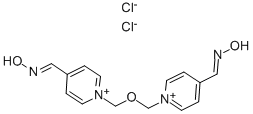Toksobidin,Polfa-Starogard
Obidoxime Chloride is a cholinesterase reactivator.
2 Methods of producing of obidoxime chloride:
1. Into a boiling agitated solution of 2.44 g pyridine-4-aldoxime in 10 ml absolute ethanol is added dropwise during the course of 25 min a solution of 1.14 g bis-chloromethyl ether in 5 ml absolute ethanol. The reaction mixture is then refluxed for 35 min, and then agitated for 5 h at room temperature. The precipitate of bis-[4-hydroxyimino-methyl-pyridinium-(1)-methyl]-ether
Trade dichloride is thoroughly washed with absolute acetone. The yield is 3.5 g which is 98% of the theoretical, and the melting point is 229°C. If convenient, the mother liquor can be reused to make additional product.
2. 12.2 g (0.1 mole) pyridine-4-aldoxime are dissolved with heating in 125 ml chloroform. Within 25 min, 8.5 g (0.075 mole), α,α-dichlorodimethyl ether in 20 ml chloroform are dropped while stirring into the boiling solution. The reaction mixture is heated for another 35 min. After standing for several hours, the precipitate is filtered off, washed with absolute ethanol, acetone and ether and dried at 80°C. Yield: 17.0 g, 95% of the theoretical, and the melting point is 225°C (dec.).
active agent in Toxogonin
Antidote for organophosphate nerve agent poisoning, but, as with other oxime agents, not full spectrum. Obidoxime fails primarily to reactivate acetylcholinesterase that has been inhibited with cyclosarin.
Poison by intraperitoneal,intravenous, intramuscular, and subcutaneous routes.Moderately toxic by ingestion. When heated todecomposition it emits toxic fumes of Cl- and NOx. Seealso BROMIDES.


